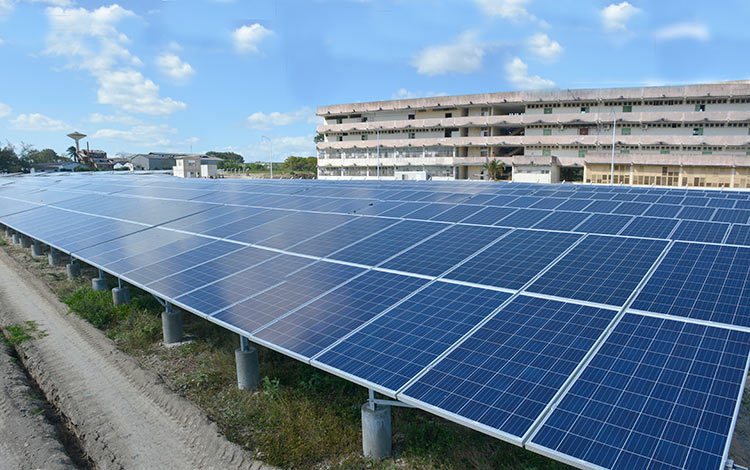
The Solar Photovoltaic Park of the Central University ‘Marta Abreu’ in the Las Villas province of Cuba.
Cuba’s new constitution will incorporate articles enshrining Cuba’s commitment to sustainable development and the protection of the environment. This is a long-standing commitment of which the most recent major iteration was an announcement in 2014 that the country aims to source 24% of its electricity from renewable sources by 2030.
Currently about 5% of Cuba’s energy is produced by renewable sources, but there is huge potential for renewable energy development due to Cuba’s geography giving it access to a variety of biofuel sources, a windy coastline and generous amounts of sunshine. Luis Hilario Berriz Perez, president of the state enterprise Cubasolar, explains that ‘Cuba’s territory, of about 111,000 square kilometres, receives solar radiation equivalent to the energy produced by 50 million tons of oil, every day. That is, the solar radiation Cuba receives in a single day, is greater – in its energy value – than all the oil consumed in five years.’ However, there are major barriers to energy development; not least the US blockade. Cuba has been forced to look outside of the US’ sphere of influence for solutions to its energy needs.
Cuba has been heavily dependent on imported oil from Venezuela, receiving an average daily import of 98,000 barrels at preferential prices between 2000 and 2015. But since 2016, the economic war waged by the US and Venezuela’s ruling class against Venezuela’s progressive Bolivarian government and masses forced Venezuela to drop its exports to Cuba by 40%. For Cuba, this has increased the urgency of energy security and sustainability.
Cuba’s existing sustainable energy infrastructure is concentrated in the production of bioenergy. This is driven by the nation’s sugar industry in which bagasse – pulp residue from the processing of sugarcane – is burned to turn turbines which generate electricity. In 2015, of the 566 megawatts (MW) of sustainable energy capacity, 83% was from bioenergy sources. As of 2016, the Cuban Ministry of Mines and Energy reported that there were approximately 2000 small-scale biodigesters across the country and 700 biogas plants (which convert animal waste into energy) operating on state and private farms. This is on top of six larger biogas facilities that were built in the two years prior. Cuba has the capacity to make 400 million cubic metres of biogas annually, which is enough to run an 85 MW electricity generation plant. This would eliminate more than three million tons of carbon dioxide emissions and would save around 190,000 tons of oil (Havana Times, 11 July 2018).
Cuba’s renewable energy development continues apace, with British firm HE Ltd (formerly Havana Energy Ltd) and Shanghai Electric Co, along with Cuban state partner Zerus pursuing in a joint venture called Biopower, a plan to construct five 62 MW plants in the next decade. In April this year, the Chinese ambassador to Cuba oversaw the opening of two solar energy farms with a total capacity of 9 MW. At the inauguration event – in which the ambassador handed over control of the parks to the Cuban government – the Cuban Deputy Minister for Energy and Mines, Reuben Cid, explained that the facilities were part of a wider project, financed by the Chinese Ministry of Commerce, with a total capacity of 21 MW. The Deputy Minister explained that, ‘To date we have worked intensely with Chinese companies and institutions to carry out two wind farms in the province of Las Tunas, 319 MW in generation through solar panel parks and several bioelectric plants next to sugar refineries.’
Cuba’s advances in sustainable development are not solely in its energy production sector. At the triumph of the revolution in 1959, 11% of Cuba was forestland. Now, 30.6% of its land is covered by forest as a result of a reforestation programme that began in 1998 and was reported as the most advanced in Latin America and the Caribbean in a 2011 report by the United Nations. As well as this, Cuba’s urban organic infrastructure, known as ‘organoponicos’, has been described as ‘an exemplary precedent that could be applied worldwide’. In Havana alone, 35,000 hectares of land are used for urban farming. The success of this programme is due to a ‘combination of top-down state support and ground-up citizen participation’ (The Architectural Review, March 2014).
In sustainable development, Cuba is consistently leading the way in the region. It is only able to realise these achievements – against all the odds – due to socialism; the system of collectivised economic planning that puts the interests of the masses first. As Cubasolar’s Perez explains, ‘Anyone can talk about sustainable development, but it is not a capitalist concept. It is a concept that necessarily involves human solidarity, in which the social being is always placed above money.’
Ben Geraghty
Fight Racism! Fight Imperialism! 265 August/September 2018




